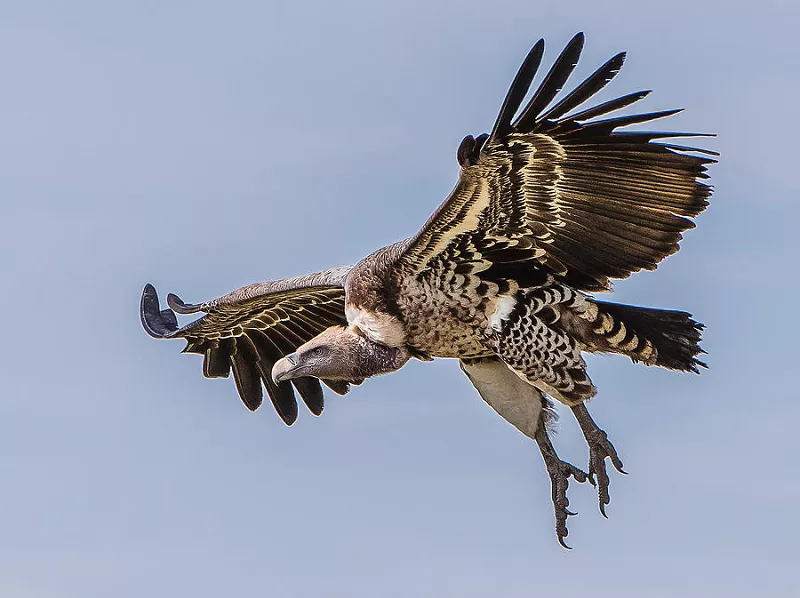The skies have always been a realm of fascination and wonder for humans, and the creatures that inhabit this vast expanse hold a particular allure. Among these avian wonders, the question of which bird can fly the highest in the world piques the curiosity of many. From the majestic albatross to the enigmatic bar-headed goose, numerous contenders vie for the title of the highest flier. In this comprehensive exploration, we delve into the world of high-flying birds, examining their physiology, behavior, and habitats to uncover the ultimate champion of the skies.
Which Bird Can Fly The Highest in The World?
The Answer: Rüppell’s Griffon Vulture
Rüppell’s griffon vulture (Gyps rueppelli) holds the record for the highest recorded flight by a bird, reaching an astonishing altitude of 37,000 feet (11,300 meters). This impressive achievement exemplifies the vulture’s remarkable aerial prowess and highlights its adaptation to extreme environments.
Details about the Rüppell’s Griffon Vulture
Physical Characteristics: Rüppell’s griffon vulture is a large bird of prey, with a wingspan that can exceed 9 feet (2.7 meters) and a weight of up to 20 pounds (9 kilograms). Its plumage is predominantly brown, with lighter streaks on the underside of its wings. Like other vultures, it possesses a bald head, which minimizes the accumulation of blood and debris while feeding on carrion.
Habitat: This vulture is primarily found in the arid and semi-arid regions of Africa, ranging from the Sahel to the Horn of Africa. It inhabits a variety of habitats, including savannas, grasslands, and mountainous areas. Rüppell’s griffon vulture is often observed soaring effortlessly on thermal updrafts, scanning the landscape below for carrion.
Behavior: As scavengers, Rüppell’s griffon vultures play a crucial role in ecosystem dynamics by consuming carrion and preventing the spread of disease. They possess keen eyesight and an acute sense of smell, allowing them to locate food sources over vast distances. Despite their large size, these vultures are surprisingly agile in flight, capable of executing tight turns and maneuvers while soaring.
How They Achieve Such Heights
The ability of Rüppell’s griffon vulture to soar to extreme altitudes is facilitated by a combination of physiological and aerodynamic adaptations.
Large Wingspan: The vulture’s expansive wingspan enables it to efficiently harness rising air currents, such as thermals and updrafts. By adjusting the position of its wings and tail, the bird can optimize lift and minimize energy expenditure during flight.
Efficient Soaring Techniques: Rüppell’s griffon vulture is a master of dynamic soaring, a technique that involves exploiting the temperature differentials between air masses to gain altitude without flapping its wings. By alternating between ascending and descending flight paths, the vulture can maintain its position in the sky with minimal effort.
Tolerance to Low Oxygen Levels: At high altitudes, oxygen levels decrease significantly, posing a challenge for birds accustomed to lower elevations. However, Rüppell’s griffon vulture has evolved adaptations that allow it to thrive in hypoxic environments. These adaptations include efficient respiratory systems and enhanced oxygen-carrying capacity in the blood, enabling the vulture to sustain flight at altitudes where other birds would struggle.
Comparison to Other High-Flying Birds
While Rüppell’s griffon vulture holds the record for the highest recorded flight, it is not the only bird known for its ability to soar to extreme altitudes. Other species, such as the Andean condor, bar-headed goose, and whooper swan, also demonstrate impressive feats of high-altitude flight.
Andean Condor: With a wingspan that can exceed 10 feet (3 meters), the Andean condor is one of the largest flying birds in the world. While not reaching the same altitudes as Rüppell’s griffon vulture, the Andean condor is capable of soaring to heights of over 15,000 feet (4,500 meters) in search of carrion.
Bar-Headed Goose: Known for its annual migration over the Himalayas, the bar-headed goose is renowned for its ability to fly at altitudes exceeding 29,000 feet (8,800 meters). This remarkable feat is made possible by the bird’s efficient respiratory system, which allows it to extract oxygen from thin air at high elevations.
Whooper Swan: While not typically associated with high-altitude flight, the whooper swan has been observed flying at altitudes of up to 27,000 feet (8,200 meters) during migration. This impressive capability highlights the adaptability of birds to diverse environments and their ability to overcome physiological challenges associated with extreme altitudes.
Interesting Facts
Challenges of High-Altitude Flight: Birds that soar to extreme altitudes face numerous challenges, including low temperatures, strong winds, and reduced oxygen levels. To mitigate these challenges, they have evolved specialized adaptations that allow them to maintain optimal performance in high-altitude environments.
Unique Adaptations: In addition to physiological adaptations, high-altitude birds exhibit behavioral strategies to cope with the demands of their aerial lifestyle. For example, they may engage in communal roosting to conserve body heat and reduce energy expenditure during periods of rest.
Conservation Concerns: Despite their remarkable abilities, high-altitude birds face numerous threats, including habitat loss, poaching, and climate change. Conservation efforts are crucial to ensuring the survival of these iconic species and preserving the fragile ecosystems they inhabit.
In conclusion, the Rüppell’s griffon vulture stands as a testament to the extraordinary capabilities of birds in the realm of flight. With its ability to soar to unprecedented heights, this remarkable species exemplifies the ingenuity of nature and serves as a reminder of the importance of preserving biodiversity in our ever-changing world. As we continue to unravel the mysteries of avian flight, let us remain vigilant in our efforts to protect and conserve the magnificent creatures that grace the skies above us.


 Facebook
Facebook  Instagram
Instagram  Youtube
Youtube 